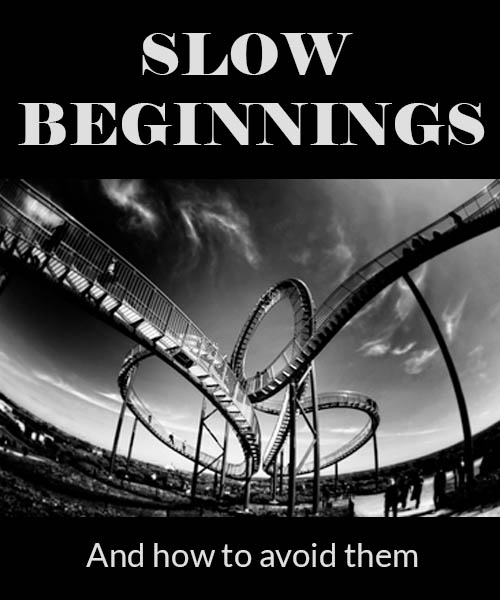
Slow beginnings and how to avoid them.

First Example:
Johnny woke up early. It was a school day so he quickly dressed. He was just a normal kid; he lived in Dayton Ohio, went to high school and had a grade average that was, well, average. On the way down to breakfast he bumped into his little sister, Anne. They said good morning, like they always did, and went into the kitchen.
Ok. Here the story hasn’t started yet. Nothing is happening. Obviously, this is an extreeeeeeemly boring example – you’d be surprised how often this kind of thing gets written.
Right – so, action? Right? Let’s start at the action.
Second Example:
The punch landed on Mike’s face like a hammer. He swung wildly into the wall and fell to his knees. The blows kept raining down on him from all sides while he struggled to regain his feet. Covering his face with his arms he managed to pull himself up and get a foot under like a sprinter on the blocks. They were kicking him now; bashing boots into his shoulder and body. He tensed, waiting for his chance. Then, with a rush, he was off and running.
Ok, stuff is happening. But do we care? Not really. There’s no context here. There’s action, but no conflict. It’s just a guy getting his ass kicked. I’ve seen stories that go on like this for three or four pages and I still had no idea what was going on (which is quite remarkable, as I wrote them myself).
If you’ve got a particularly strong writing voice you may be able to carry a reader’s attention through one of these kinds of beginnings. For most of us though, it pays to make sure we start with some conflict.
Third Example:
Vincent couldn’t afford to be late for a third time this week; Mr Davis would kill him. He drove as fast as he dared, balancing the risk with the dread of losing his job. Going back to living in mother’s basement just didn’t appeal. The light was just turning red as he flew across the intersection of 12th and Main. He didn’t spot the Police Prowler in the nearside lane until it pulled out into the road behind him.
Conflict requires establishing four things:
-
-
-
- A character we can identify with
- Something that character wants
- Something that stops her getting it
- The consequence of failure
-
-
Read your first paragraph. Have you got conflict? If not, why not?
